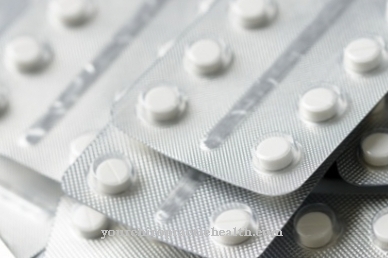Under the term Sulfonylurea different drugs are summarized that are used in the therapy of diabetes mellitus. Sulfonylureas are used as blood sugar lowerers in combating type 2 disease. The drugs achieve this profile by increasing the secretion of insulin. Sulphonylureas are therefore antidiabetic agents.
What are sulfonylureas?
Sulphonylureas are important antidiabetic drugs that are used to combat type 2 diabetes mellitus (often called sugar disease in the vernacular). Use with type 1 is not indicated. The drugs are to be differentiated from the group of glinides. Although these have a similar mechanism of action as sulphonylureas, they have significant differences in terms of their action profile. In pharmacology and chemistry, sulfonylureas can be described by the empirical formula C 24 - H 3 - N 4 - O 5 - S.
The standard field of application of sulfonylureas is the regulation of the blood sugar level. The drugs influence the insulin content after ingestion, so that a relevant lowering of the blood sugar is achieved.
Since sulfonylureas are only taken orally, they are considered oral antidiabetic agents. They play an important role in therapy. In the Federal Republic of Germany and other EU countries, drugs are subject to pharmacy and prescription requirements. It can only be purchased after a doctor's prescription.
Pharmacological effect on the body and organs
Sulphonylureas work by stimulating the potassium channels in the beta cells of the pancreas, which increases their activity. This excitement leads to an increased production of insulin. Because of the increased release of insulin, the insulin content in the blood rises, which leads to a noticeable lowering of blood sugar.
Sulphonylureas are considered to be potassium channel blockers because of their effect on the potassium channel. The effects are achieved by mimicking an increased concentration of ATP. Since sulfonylurea only increases the body's own production of insulin, the therapy requires a functioning pancreas. The patient still needs to be able to produce sufficient amounts of insulin.
Since the term sulfonylurea is a collective term under which various active ingredients are summarized, there are some differences between the individual substances. The differences, however, are limited to the speed and duration of the onset of action.
The most common sulphonylureas include the drugs gliclazide, tolbutamide, glimepiride, glibenclamide and glibornuride. Which active ingredient is used is determined by the individual characteristics of the individual case.
Medical application & use for treatment & prevention
The use of sulfonylureas has proven itself in human medicine for the treatment of type 2 diabetes mellitus. The first preparations came on the market as early as 1956. Today, sulfonylureas are mainly used in mono preparations. These are drugs that rely exclusively or primarily on one active ingredient. However, a combination with other active ingredients such as metformin is also possible.
The prescription is only given for the treatment of type 2 diabetes. However, the prerequisite is always that the pancreas is functioning properly. Otherwise, other preparations must be administered.
Sulphonylureas are taken orally in the form of film-coated tablets. Various preparations are on the market in the European Union. All sulfonylureas are subject to pharmacy and prescription requirements because of the risk of side effects. A purchase is therefore only permitted after a prescription has been issued in a licensed pharmacy.
It is essential to pay attention to the medical advice when taking it. In particular, it may be necessary to coordinate the intake of the preparations with the daily meals.
Risks & side effects
Sulphonylureas are not free from risks and side effects. The application safety is guaranteed, however, provided there is no contraindication. This is the case during pregnancy and breastfeeding, for example. The intake then has to cease. The same applies to patients with severe liver or kidney damage. In type 1 diabetes mellitus, there is also a contraindication due to the lack of effectiveness.
Since sulphonylureas have an effect on blood sugar levels, interactions with other medicinal products must be observed. The attending physician must always be informed of all preparations taken. For example, undesirable interactions with oral contraceptives or thyroid hormones are possible. With these there is a reduced effectiveness.
The effects of sulfonylureas can also be increased by taking beta blockers or insulin. Furthermore, interactions with thiazide diuretics, MAO inhibitors, salicylates and sulfonamides are possible.
Furthermore, side effects should be observed. The possibility of hypoglycaemia caused by the insulin should be pointed out primarily here. The likelihood of this side effect occurring is greater for substances with a long duration of action such as glibenclamide than for substances with a short duration of action such as tolbutamide.
Other side effects of sulfonylureas include alcohol intolerance, gastrointestinal symptoms (nausea, vomiting, diarrhea), general malaise and anemia.
In addition, treatment with sulfonylureas usually results in a weight gain of around 2 kg.



























